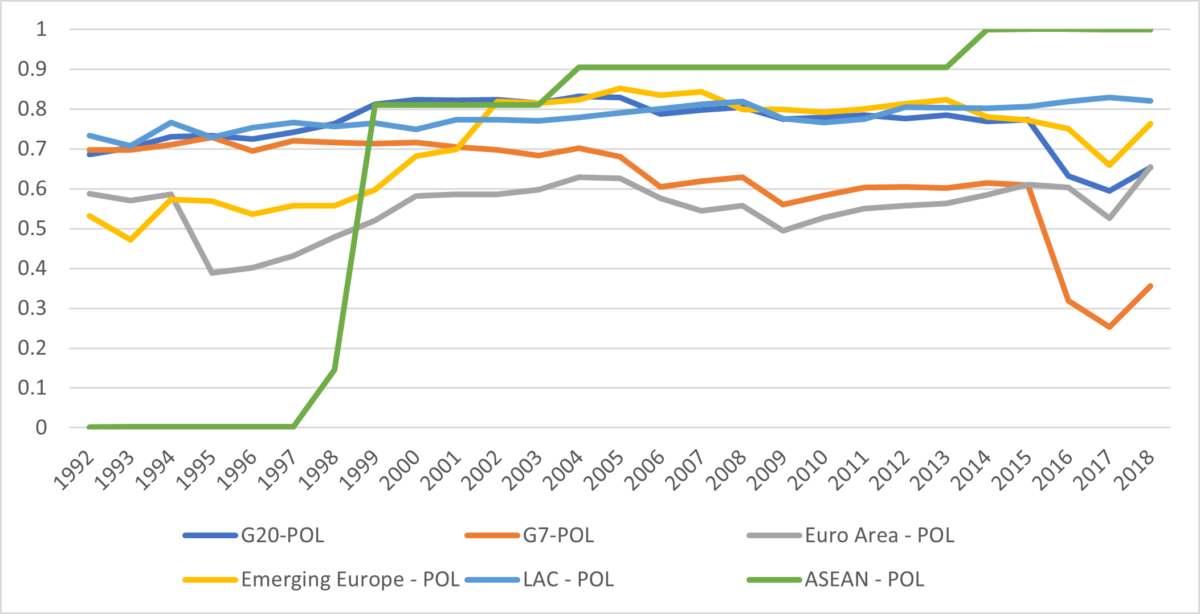At this time we’re happy to current a visitor contribution written by Christopher A. Hartwell (ZHAW Faculty of Administration and Legislation, Switzerland), and Pierre Siklos (Professor Emeritus at Wilfrid Laurier College; and Balsillie Faculty of Worldwide Affairs, Canada).
A paper by the 2 of us, forthcoming within the Worldwide Journal of Central Banking, makes the case that poorly performing central banks – particularly, ones that regularly miss their inflationary targets – not solely undermine their very own credibility, but in addition undermine a rustic’s institutional high quality. Due to this fact, when asking: What Harm Can a Poorly Performing Central Financial institution Do? The reply is: rather a lot, truly. Such a conclusion has far-reaching ramifications for institutional improvement, resulting in much less total financial resilience.
Ever for the reason that coverage of central financial institution autonomy unfold across the globe, financial authorities have performed, some would say, an outsized function in figuring out the trail of a rustic’s economic system. Given this significance, we hypothesize that how a central financial institution performs can have a considerable affect on not solely the efficiency of the economic system however the energy of its establishments. For instance, short-term declines in central financial institution credibility, a movement variable, indicate a parallel decline within the total belief positioned in central banks, with belief a slower-moving stock-like variable. If this belief begins to ebb away from the central financial institution, there’s the potential to degrade a rustic’s establishments extra broadly. Weaker establishments translate into much less institutional resilience in an economic system. We consider resilience as the power of a rustic to face up to shocks, probably of each the financial and political selection.
To quantify this relationship, we assemble an index of institutional resilience encompassing financial elements (e.g., extent of property rights, extent of openness to commerce and finance, and adaptability of alternate charges) and political ones (e.g., democracy, govt constraints, and the fiscal dimension of presidency). This index captures attributes that should be positively correlated with resilience, aside from dimension of presidency, which needs to be negatively correlated (a big authorities has little room to maneuver within the face of shocks). The graphs beneath illustrate our findings for financial and political resilience (the index ranges from 0 to 1) for chosen nation teams, though we’ve generated these indices for every of the over 90 particular person nations in our knowledge set (representing over 80% of world GDP). Whereas our knowledge return to the Nineteen Sixties, it’s only by the Nineteen Nineties that the widest array of variables thought-about are constantly accessible for nations past the superior economies. As proven beneath, the Nineteen Nineties and 2000s have seen a worldwide rise in central financial institution resilience though there’s appreciable variation over time and the gaps between the nation teams proven present fewer indicators of convergence by the tip of the pattern that within the early Nineteen Nineties. Gaps in political resilience stay all through the pattern thought-about and there’s a marked drop for the G7 nations starting in 2015 that predates the pandemic and up to date occasions. The G7 had been among the many most politically resilient within the early Nineteen Nineties.
Determine 1: Financial Resilience. Larger scores indicate better resilience

Determine 2: Political Resilience. Larger scores indicate better resilience
We array this index towards a measure of central financial institution effectiveness, which is linearly comprised of three separate elements. First, we examine a central financial institution’s inflation efficiency towards both said targets – within the case of inflation concentrating on – or towards an implicit objective (a five-year shifting common of inflationary outcomes) – the place banks haven’t any pre-stated objective. Second, we style a measure of financial coverage uncertainty, measuring divergence of inflation and output outcomes versus forecasts. Lastly, we measure how out of step a rustic’s inflation efficiency is with the world.
Utilizing generalized technique of moments (GMM), mannequin choice strategies, and a neighborhood projection estimation from a VAR, we discover that every p.c decline in a central financial institution’s credibility corresponds with a mean 3.6% drop in a rustic’s institutional resilience for the reason that Nineteen Nineties. Plainly put, the extra {that a} central financial institution loses confidence by way of lacking inflation targets or veering from international tendencies, the extra hurt it does to total institutional resilience in a selected nation.
The ramifications from this analysis as soon as once more spotlight that central financial institution autonomy could result in higher inflation outcomes, however a central financial institution can nonetheless pursue poor insurance policies or be ineffective even when independence is managed for. A greater performing central financial institution, that’s, one which primarily focuses on value stability, is healthier for an economic system; extra importantly, with central banks enjoying such an necessary institutional function in an economic system, a rustic’s total institutional high quality can also be depending on how properly a central financial institution performs. Whereas our outcomes relaxation on imperfect indicators we’ve tried, throughout the constraints of information availability, to ascertain the sensitivity of our outcomes to modifications in definition, modifications in pattern durations, and sources of information. Our major findings stay considerably sturdy throughout estimation strategies employed.
This publish written by Christopher Hartwell and Pierre Siklos.




